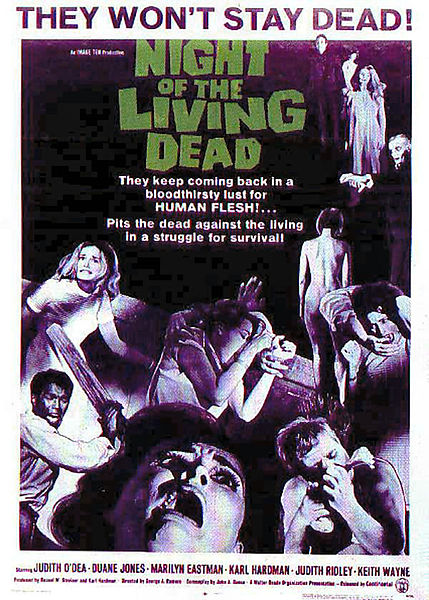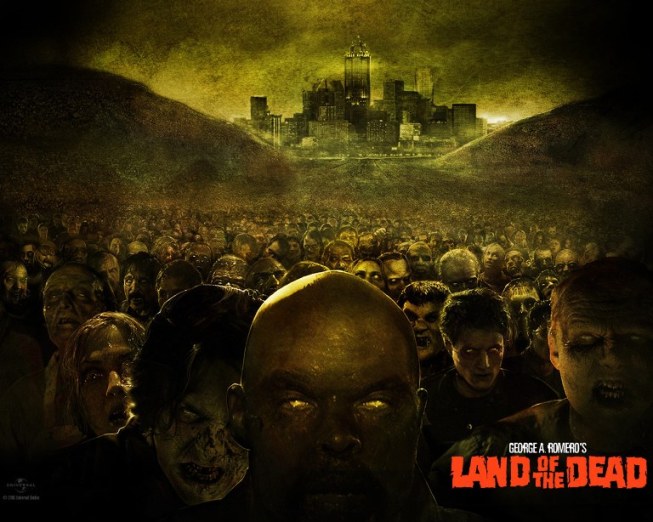Review: Romero’s ‘…of the Dead’ Series

Most people who know zombies know that there is one name that stands well above the rest when it comes to the masterful creation of an amazing zombie film - George A. Romero. If you claim to be a zombie fan and don’t know this name, you should be ashamed of yourself, for it was Romero who was the grandfather of all the conventions of zombie horror that we hold dear today.
Eating the flesh of the living? That’s his thing. Taking out the brain to kill them? His as well. Shambling hordes of mindless undead, biting people and infecting them as they swarm the world? Yup, Romero invented that too. Therefore, it is important (at least in my opinion) for every person that tunes into a show such as The Walking Dead weekly to go back and see where it all began.
Romero’s work in the zombie genre is so important that there are many people who have taken to examining his films in an academic fashion. It is well-known that Romero did more than just throw humans in a zombie-infested world and create some splatter-horror out of it. He was a social commentator throughout all of his films, zombie-plagued or otherwise, so there’s a lot to be learned if you read (watch?) between the lines. I don’t plan on going into that particular examination in this article, however, since there are plenty of others who have already done it and did it much better than I can hope to.
If you want to read up on how the original Night of the Living Dead influenced our view of zombies today, check this article out. If you’re interested in an in-depth examination of what one person believes Romero was saying socially and politically with his films (at least up to the 2005 Land of the Dead), check this other one out. Here, I plan on reviewing the six “…of the Dead” films and letting you know why you should watch them. So on with the show!
Night of the Living Dead (1968)
Night of the Living Dead was a film that was so scary for its time that it caused a bit of controversy. Zombies eating the living flesh of humans? Horrible! People turning against each other despite the terror which assaulted them? Inhumane! With no definable victory against the undead by show’s end, this one made people squirm. Considering that it was 1968, it’s no wonder.
The basic premise of NotLD is that some people end up trapped in a house while hordes of the risen dead begin to congregate outside, preventing them from escaping. Those people don’t get along so well, as is standard for horror, and their numbers eventually dwindle as the movie progresses. This one can look basic to a person that has been saturated in the zombie genre, but it really did break the mold. NotLD established a very specific set of rules for how zombies should act in the future, along with giving them a list of strengths and weaknesses with which to define the parameters of the tension in zombie horror. If Romero had not made this film, none of us would be watching The Walking Dead today.
Dawn of the Dead (1978)
Ten years later, Romero finally got back to making another zombie flick. This one follows a group of four that escape from the descending zombie apocalypse and make camp in an old mall. By using their brains (and some guns, of course), they manage to make the mall their new home. The main enemy they end up facing, however, turns out to be other human beings wanting to take what they've worked hard to secure.
This film breaks away from NotLD in that it is the first to really look at the zombie menace as being something that could overrun the world. While the first was a classic horror film, this one is a battle for survival of the highest sort. There is no haven in Romero’s new world except that which you make for yourself. By far my favorite of the series, DotD takes the zombie menace to the next level and sets the stage for others to create fully infested worlds where human beings are the minority.
Day of the Dead (1985)
Day of the Dead presents another scenario in a world overrun by zombies. This one takes place in a military installation below the ground. A group of military people, along with some civilian scientists, try to stay alive while seeking out a potential cure (or a quick solution) for the undead disease.
Again, Romero makes the human beings into the bad guys, as those living within the installation find themselves more at threat from each other than the hordes of zombies waiting outside. While not as clean as Dawn of the Dead, this third installment presents some new elements, showing that the dead do indeed retain some of their human intelligence and raising the question of whether the living are any better than the dead.

Land of the Dead (2005)
It took twenty years for the forth film to finally get made, but Land of the Dead is really the culmination of everything Romero is saying throughout his series. This time the setting is a city, walled off from the infested world and trying to operate as if things were somewhat normal. But humans are always screwing things up, and thus the new world of safety is little more than a shadow of the way things were before the zombies arrived. People jockey for position over each other in an effort to gain and maintain power and the general masses care little for reality as long as they are safe, well fed and entertained.
This is where Romero concentrates on his running theme of zombies as thinking creatures. The undead not only remember their own lives and try to imitate their living actions, they also figure out how to do things like manipulate tools. In Land of the Dead, we are presented with a zombie race that could very likely replace humanity and, if Romero is to be believed, the world might just be the better for it.
Diary of the Dead (2007)
The fifth film is where Romero’s series starts to go awry (though some would argue it was Land of the Dead where it began to falter). This one takes place at the very beginning of the zombie outbreak and follows a group of teenagers as they seek to find a place to hide out and let everything blow over. It uses the documentary style of filmmaking that gained a lot of popularity during this time.
Personally, I liked this film. It is very much a “teenagers in trouble” horror flick, but it still carries enough atmosphere to make it enjoyable. As far as an overall story goes, it could have been much better, but it’s still head-and-shoulders above the vast majority of zombie movies out there.
Survival of the Dead (2009)
And here is where the whole series falls flat. Survival of the Dead takes a group of survivors to an island where they think they can live away from the zombie menace. Unfortunately, the island has its own problems, including two warring clans that, even in the midst of humanity’s fall, still can’t get along. There is also the added element of human beings thinking that they can keep the zombies around and then cure them later, since the whole thing is just a disease.
While this movie presents the viewer with Romero’s vision of human beings being the real enemy, the actual plot and story are mediocre at best. If you want to finish the series, you have to sit through this one, but it’s not going to leave you feeling like you’ve completed something grand. Most likely you’ll just shrug and go rewatch one of the first films.
In my own opinion, the first four are a must to watch. After that, you have to judge how much of a Romero fan you really are. The message that Romero was putting out there about humanity is contained well within the series of four and the last two only serve to demonstrate that message in slightly different and less expertly executed ways. Regardless, George A. Romero was, and always shall be, the man who gifted us with the zombie-infested world that we know and, as a result, all the wonderful stories that we get to enjoy today.
Night of the Living Dead poster courtesy of lonutzmovie via Wikicommons
Land of the Dead promo courtesy of thinkzombie.com

1 comments